This spicy salsa is what I like to call the Harvest Special.
If you planned it right this summer—and started those first seeds last fall, however early that may seem—everything that goes into this salsa can come straight from your garden right about now, from the garlic to the tomatoes.
Related: Find First and Last Frost Dates Accurately with This Custom Planting Calendar
But why fermented salsa? Why not normal salsa like you’ve always made?
I’ve used this same recipe for non-fermented salsa and it’s fine. Great, actually. But fermentation pushes it over the line to fantastic.
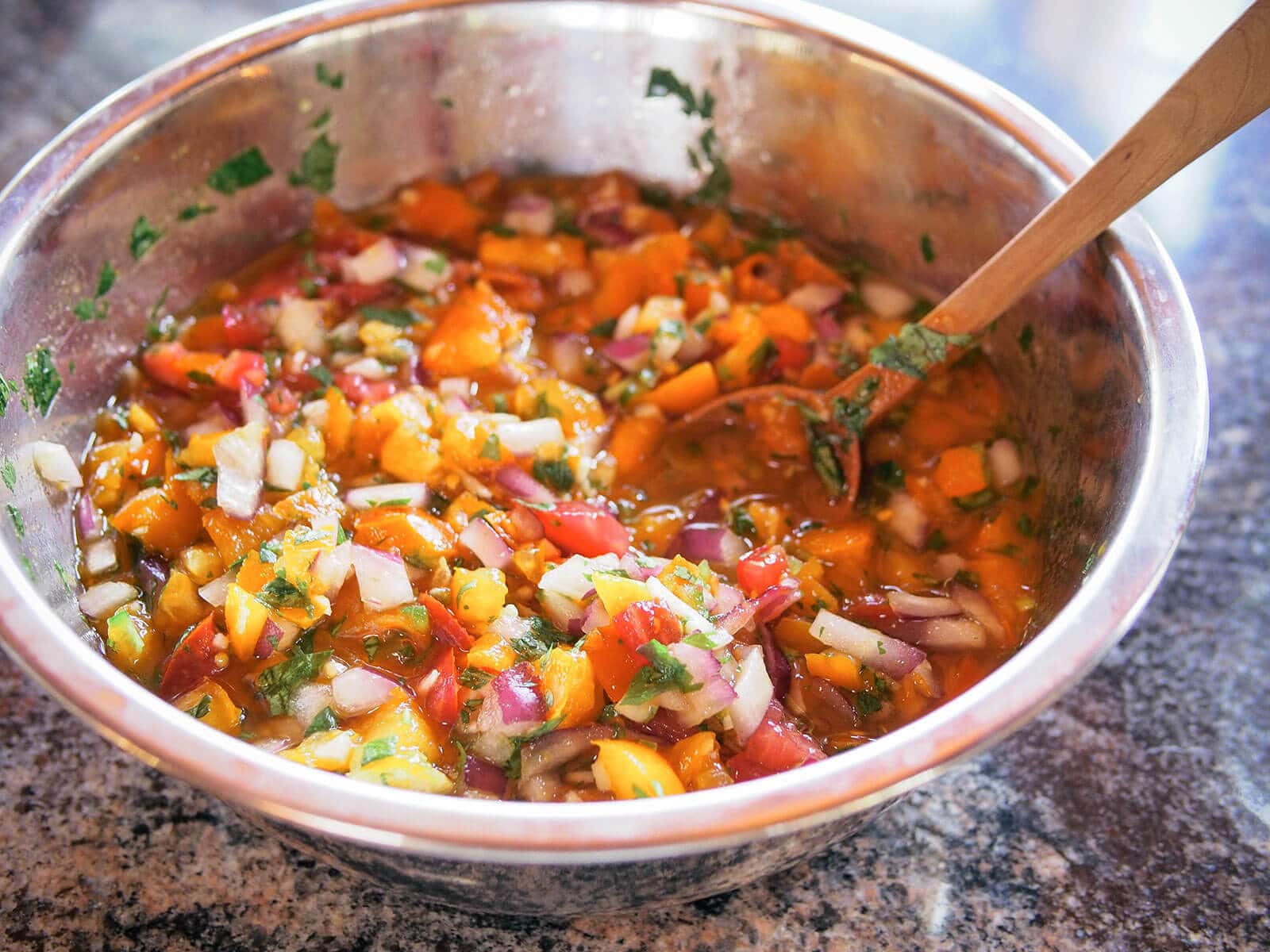
The same bacteria and yeasts that give kraut and kimchi their distinctive flavors also give this salsa a bright and tangy note. It’s lively on the tastebuds without being too sour or too salty.
But taste aside, fermentation actually makes this salsa good for you (and good for your gut) by turning it into a probiotic-laced snack food you can enjoy guiltlessly or “sneak” to picky eaters.
That’s because fermented salsa undergoes the same process of lacto-fermentation as sauerkraut. Simply by letting your salsa sit out for a few days on the counter at room temperature, you encourage all kinds of beneficial bacteria to multiply—the ones you actually want in your food.
Make this next: Fermented Hot Chile Sauce
While many recipes for fermented salsa call for the addition of whey or starter culture, this one lets the existing bacteria (that are already present in all your fresh produce) do the work. It may take a day or two longer to ferment, but the ease of preparation is worth the small wait.
Since you want to help all that good bacteria thrive, I recommend using the best ripe, organic tomatoes if you’re not growing them yourself.
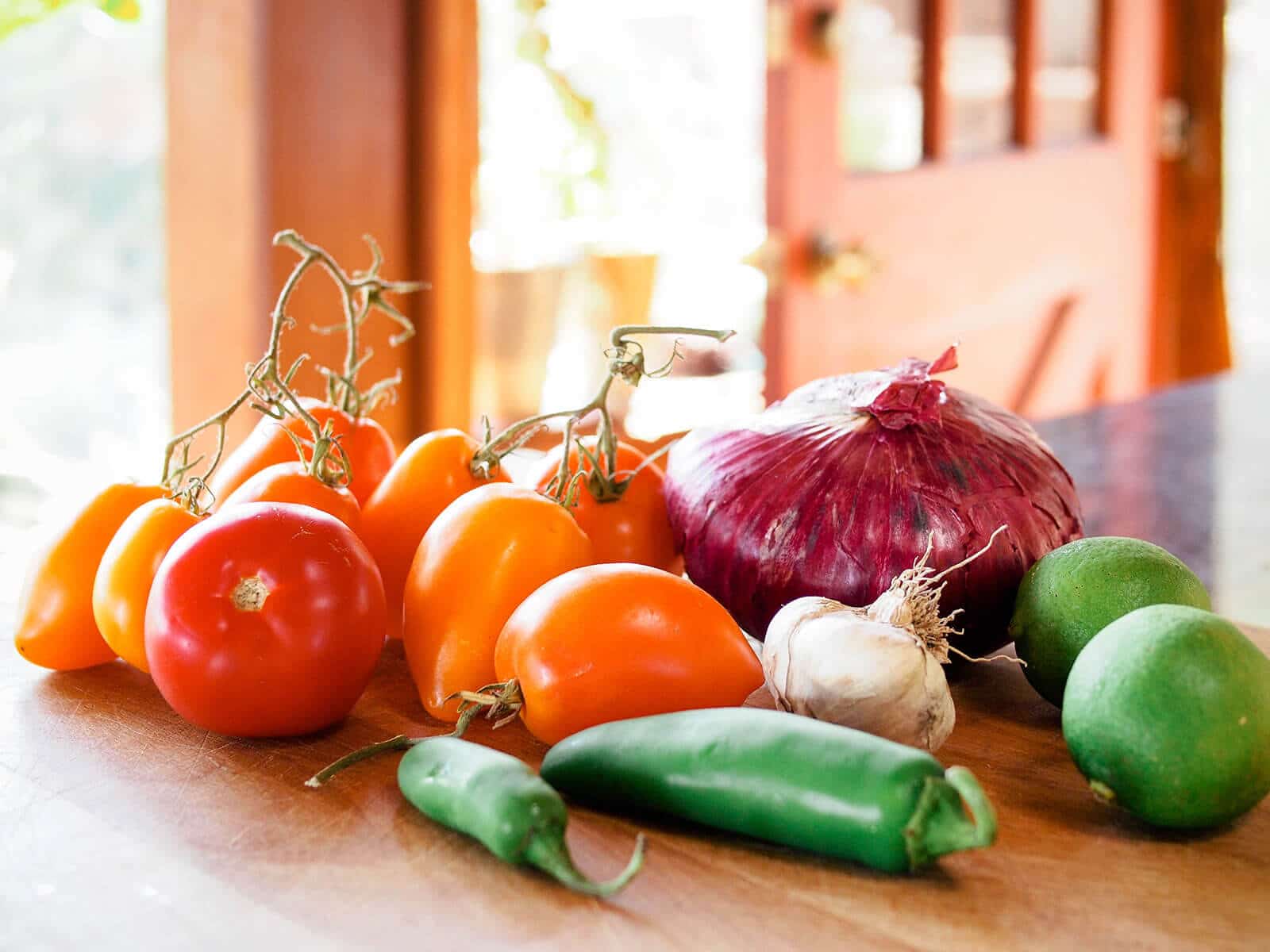
Spicy Fermented Salsa
Makes 1 quart
Ingredients
1 1/2 pounds tomatoes, diced
1/2 red onion, diced
1/2 to 1 jalapeño pepper, minced (depending on heat preference)
1/2 serrano pepper, minced
5 cloves garlic, minced
1/2 cup chopped fresh cilantro
1/2 teaspoon ground cumin
1 teaspoon pickling salt or sea salt
Juice from 1 lime
Extra-virgin olive oil
Instructions
In a medium bowl, mix the first nine ingredients together (including the seeds and juices from your tomatoes).

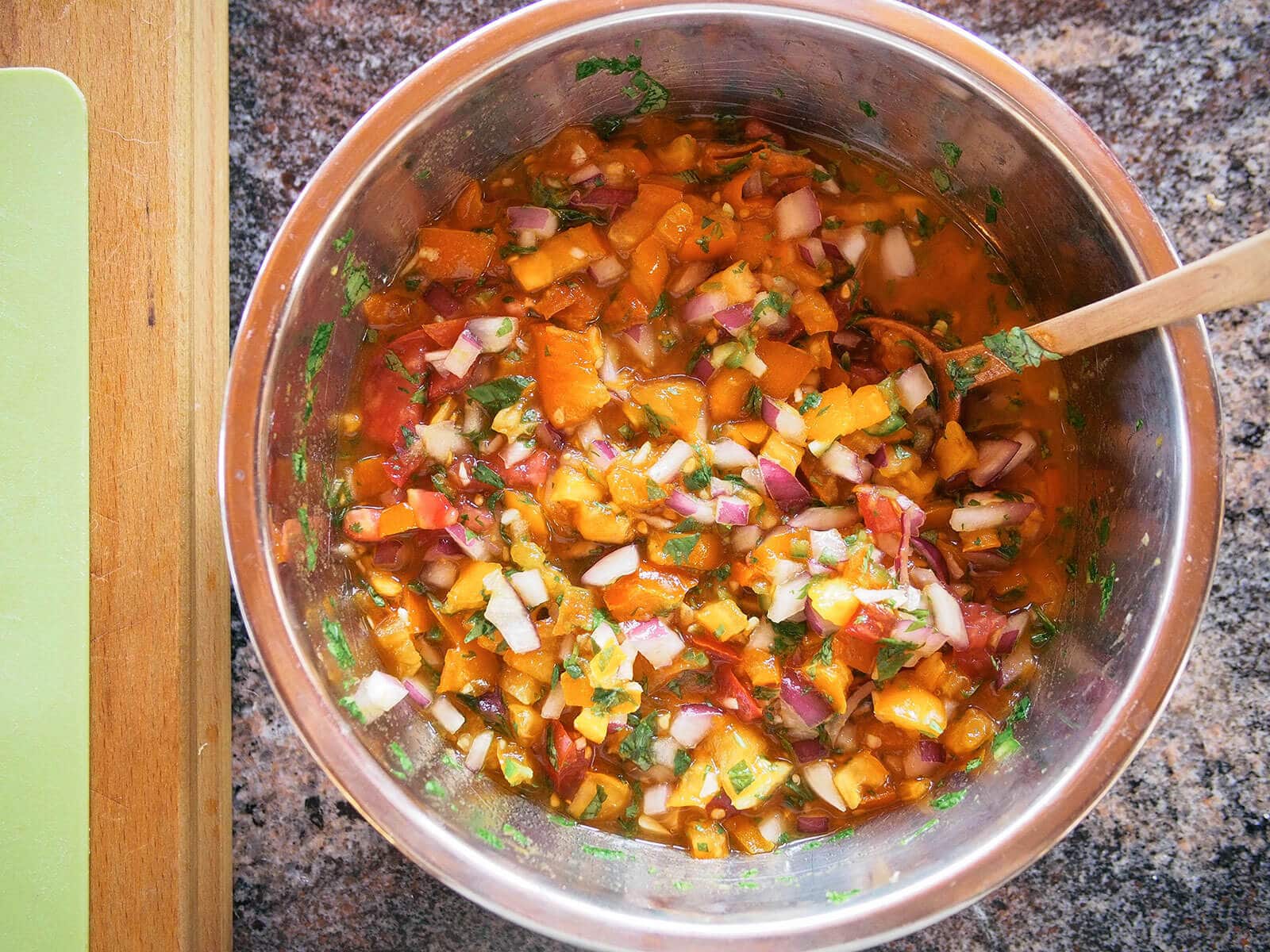
Pour the salsa into a quart-sized jar and run a chopstick around the jar to release any trapped air bubbles.
Add a 1/2-inch layer of olive oil on top. The olive oil serves two purposes here: one, it prevents the vegetables from rising above the water and growing mold on the surface, and two, it adds richness to the salsa once you mix it in.
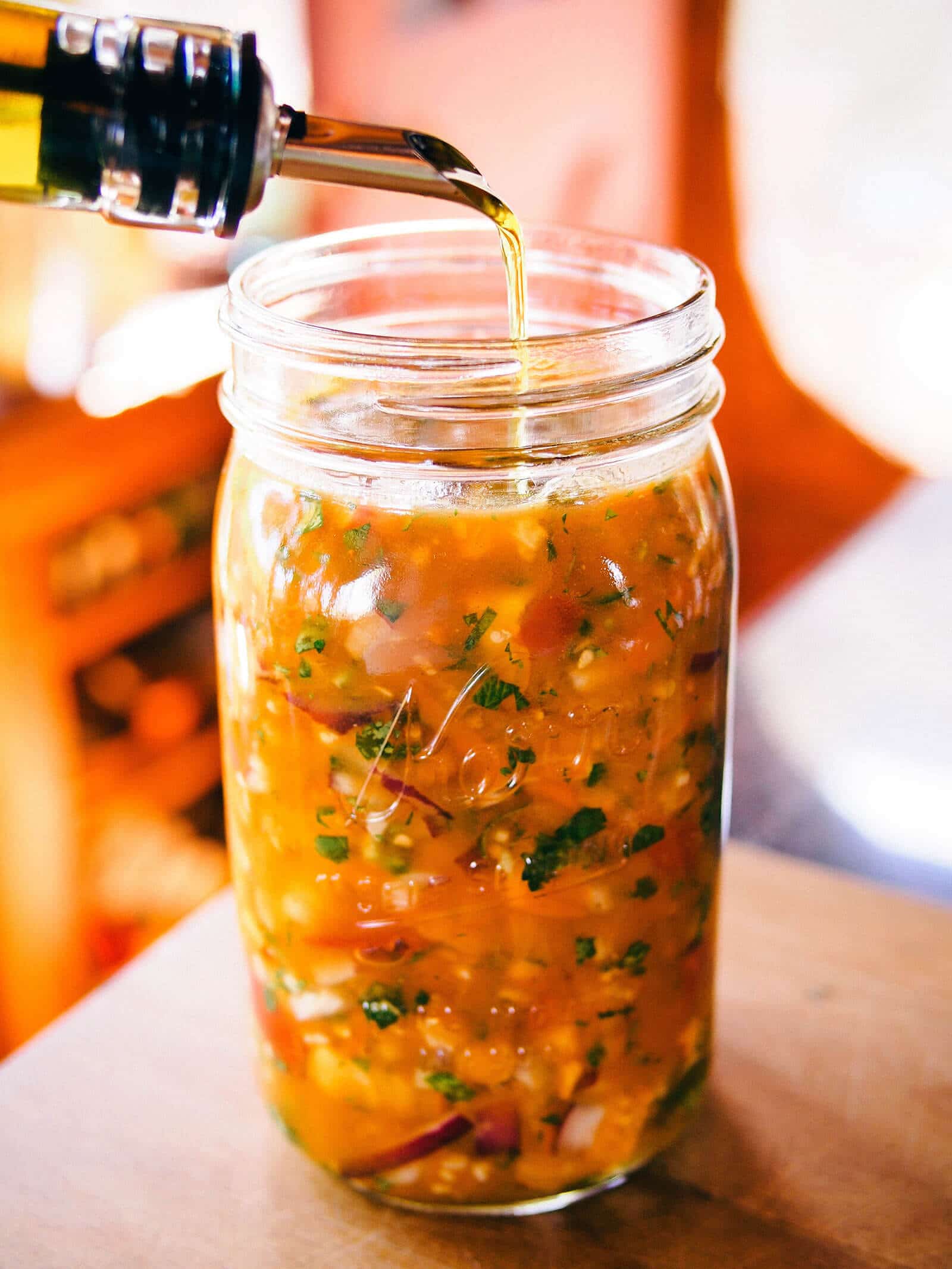
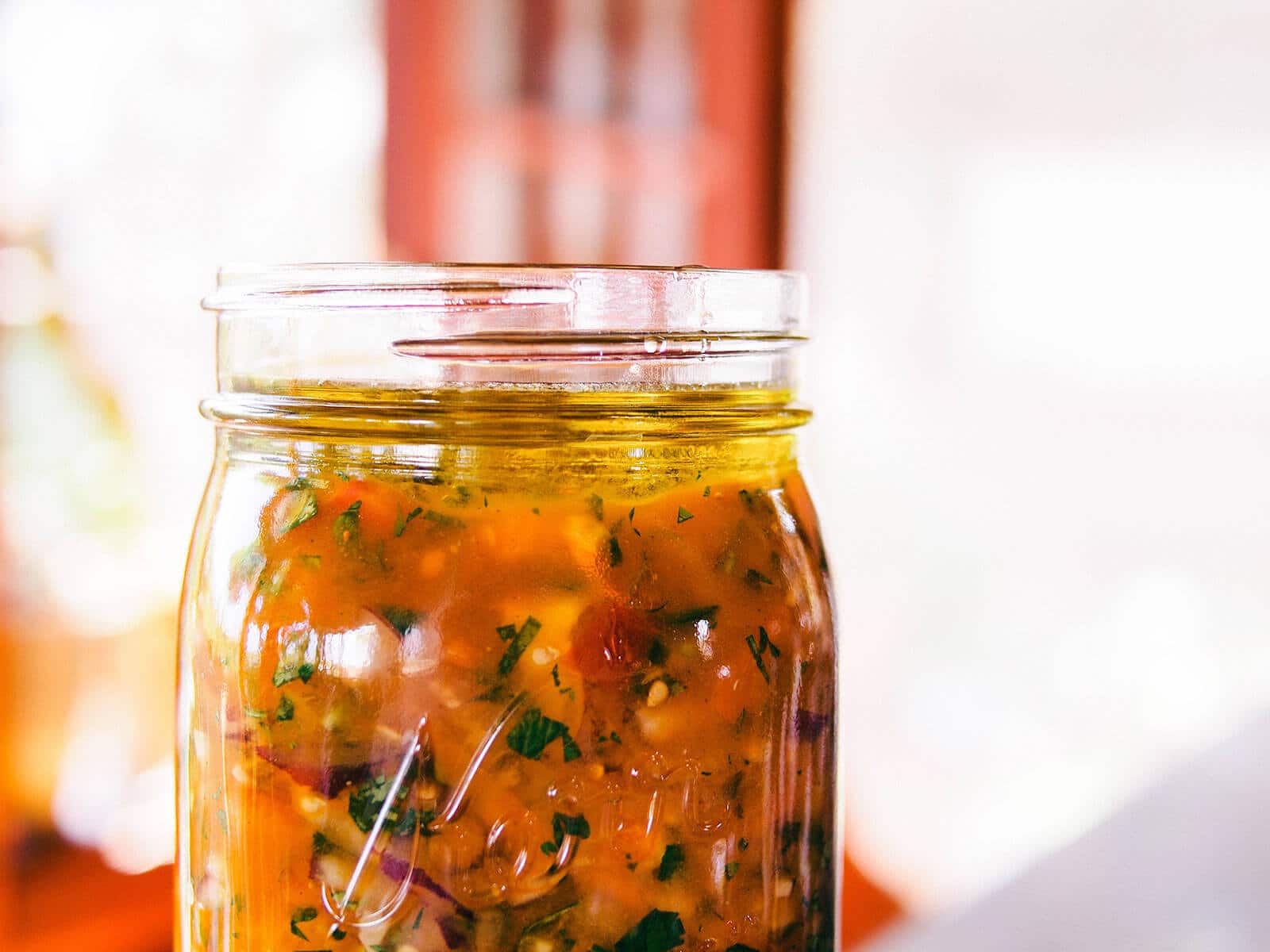
Loosely seal the jar with a lid and leave it out of direct sunlight for a few days. (I spin the lid only a couple times—enough to keep out dust and pantry pests, but loose enough to let fermentation gases escape.)
The warmer your room temperature is, the faster your salsa will ferment. Within a day or two, you’ll start to see fizzies in the juices as the lactic acid bacteria grow and flourish.
In my very warm kitchen this summer, it took four days for all the ingredients to meld and develop a bold, tangy flavor. You could leave it for up to a week for the tang to intensify; the longer you let it ferment, the longer the salsa will keep. (Not that it would ever last that long in this household!)
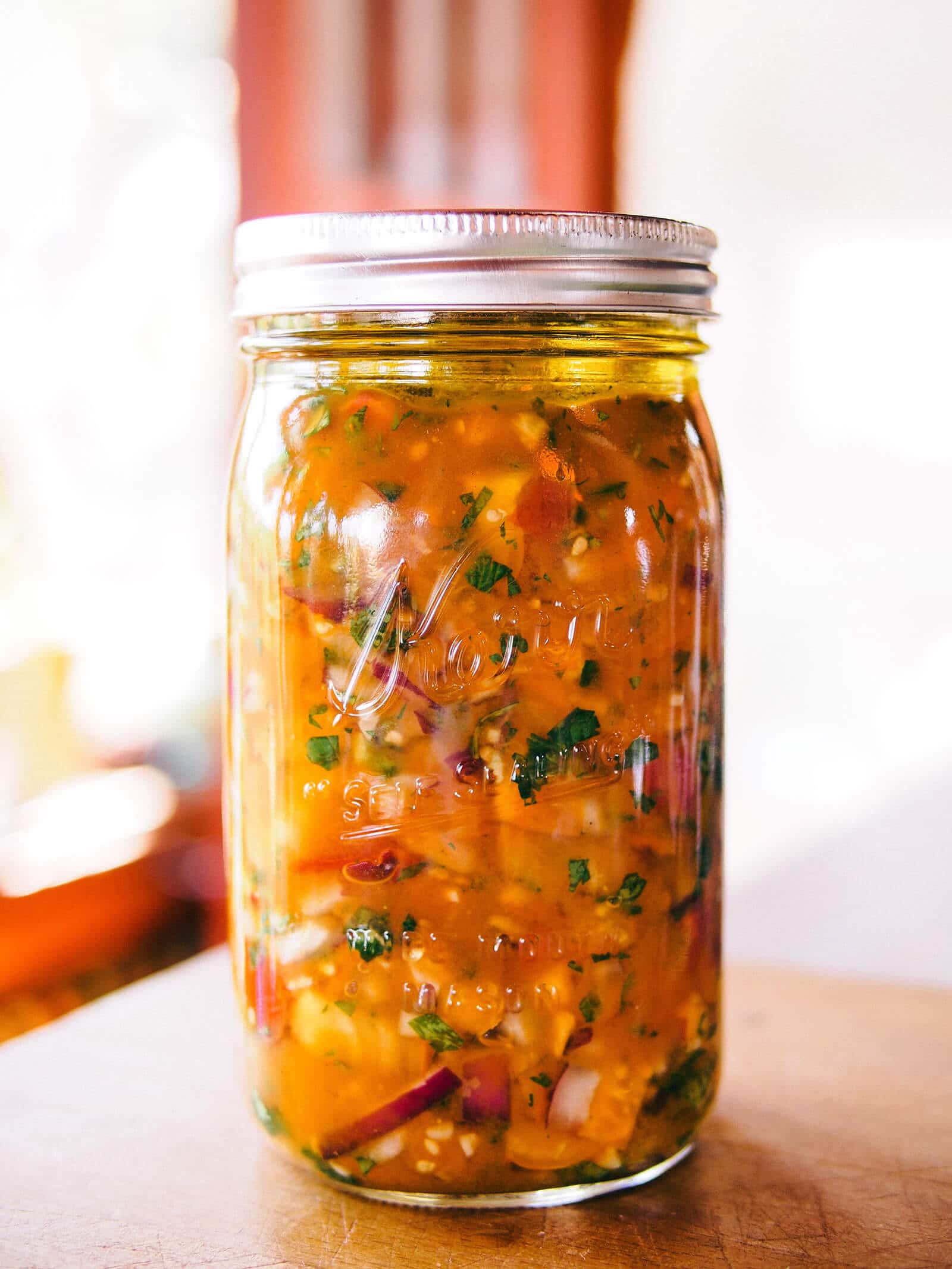
Once the salsa’s to your liking, refrigerate the jar to slow down the fermentation process (and keep the salsa from getting too sour).
The olive oil will congeal in the cold temperature, but is perfectly safe to eat. Just mix it in with a spoon before you use the salsa, or let the jar rest at room temp before serving.
Spicy Fermented Salsa
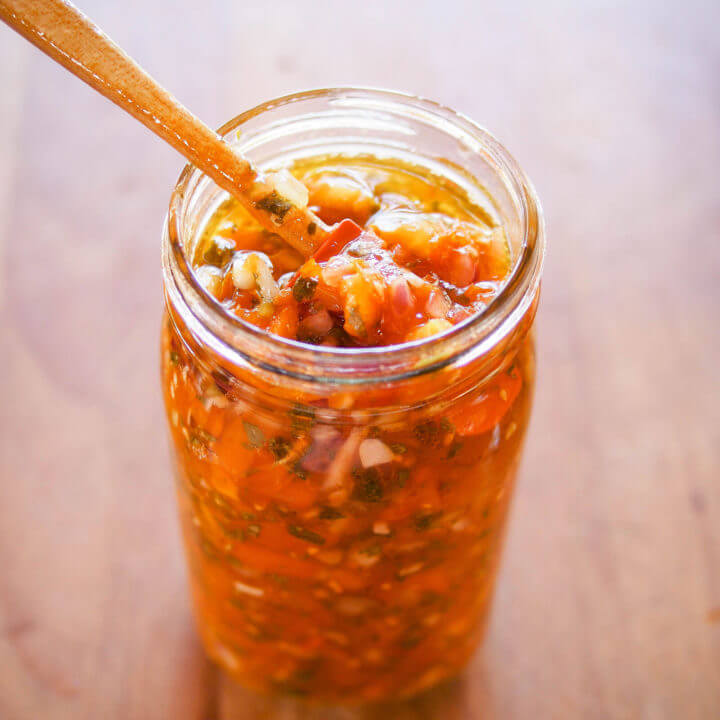
How do you take a salsa that's already great and push it over the edge to fantastic? With fermentation! Fermented salsa brings all the health benefits of good bacteria to the ripe and juicy summer tomatoes you already love. And, it couldn't be easier to make!
Ingredients
- 1 1/2 pounds tomatoes, diced
- 1/2 red onion, diced
- 1/2 to 1 jalapeño pepper, minced (depending on heat preference)
- 1/2 serrano pepper, minced
- 5 cloves garlic, minced
- 1/2 cup chopped fresh cilantro
- 1/2 teaspoon ground cumin
- 1 teaspoon pickling salt or sea salt
- Juice from 1 lime
- Extra-virgin olive oil
Instructions
- In a medium bowl, mix the first nine ingredients together (including the seeds and juices from your tomatoes).
- Pour the salsa into a quart-sized jar and run a chopstick around the jar to release any trapped air bubbles.
- Add a 1/2-inch layer of olive oil on top. The olive oil serves two purposes here: one, it prevents the vegetables from rising above the water and growing mold on the surface, and two, it adds richness to the salsa once you mix it in.
- Loosely seal the jar with a lid and leave it out of direct sunlight for a few days. (I spin the lid only a couple times—enough to keep out dust and pantry pests, but loose enough to let fermentation gases escape.)
- The warmer your room temperature is, the faster your salsa will ferment. Within a day or two, you'll start to see fizzies in the juices as the lactic acid bacteria grow and flourish. It may take up to four days for all the ingredients to meld and develop a bold, tangy flavor. You could leave it for up to a week for the tang to intensify; the longer you let it ferment, the longer the salsa will keep.
- Once the salsa's to your liking, refrigerate the jar to slow down the fermentation process (and keep the salsa from getting too sour).
Notes
Once refrigerated, the olive oil will congeal in the cold temperature, but is perfectly safe to eat. Just mix it in with a spoon before you use the salsa, or let the jar rest at room temp before serving.
Nutrition Information:
Yield:
4Serving Size:
1 cupAmount Per Serving: Calories: 76Total Fat: 4gSaturated Fat: 1gTrans Fat: 0gUnsaturated Fat: 3gCholesterol: 0mgSodium: 302mgCarbohydrates: 10gFiber: 3gSugar: 5gProtein: 2g
Nutrition information isn't always accurate.
This post updated from an article that originally appeared on September 19, 2013.
View the Web Story on how to make fermented salsa.


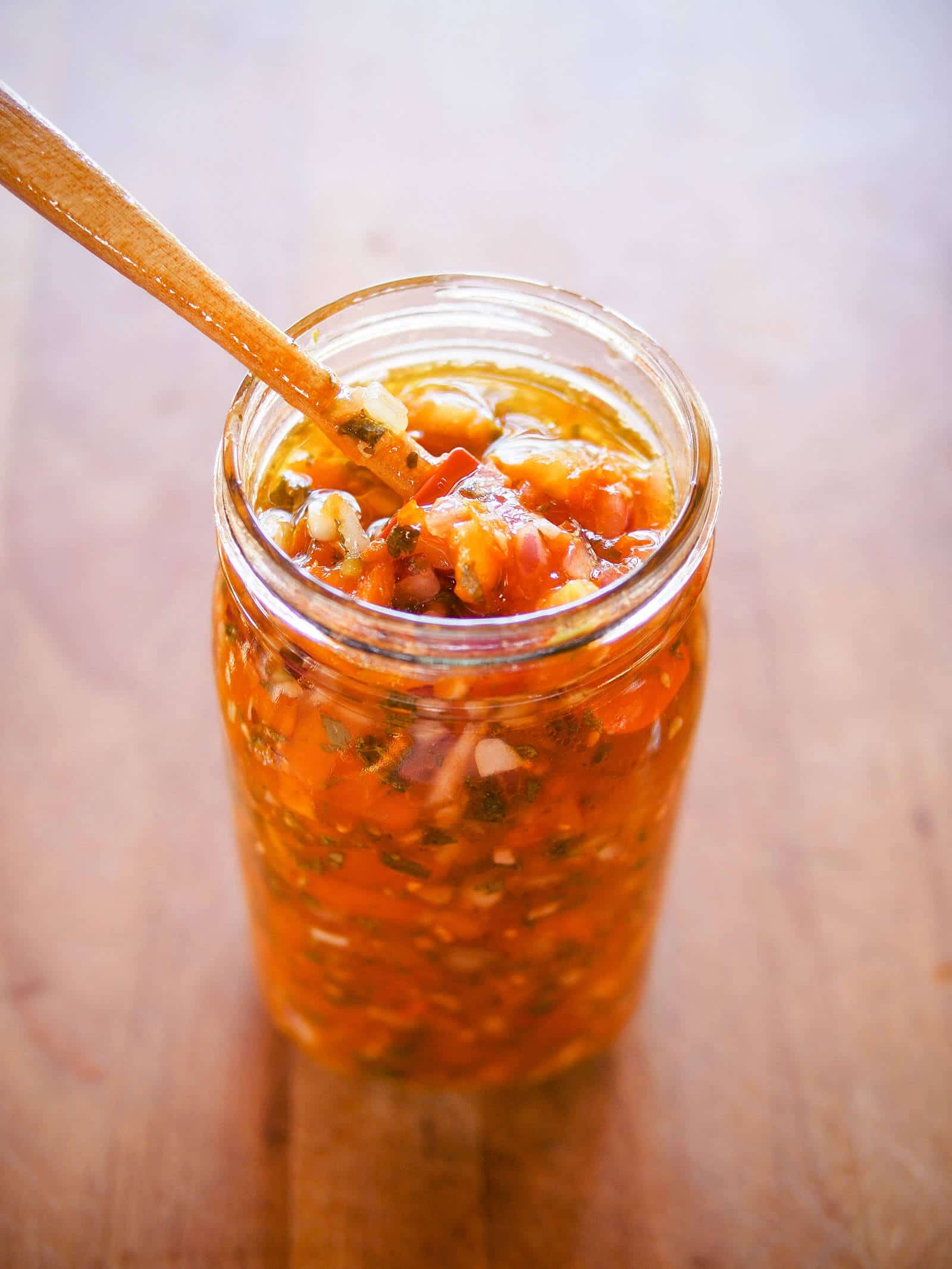













My guess is not enough salt. Some salt is needed to slow down the fermentation and inhibit bad stuff from growing. Too little salt and you will get little or even no fermentation.
I have a question about tang. I bought a fresh salsa and put it in the fridge. Before its expiration date, I tried eating it and it had an unusual taste sharp with a fizzy quality. I’d never bought that brand before so I thought it was intentional and that I didn’t like that company’s style, but then I realized it reminded me both in flavor and fizzy-ness of a mimosa made with sparkling wine (in other words, like the difference between the flavor of a juiced grape vs. the flavor of wine). I concluded that it had fermented somehow, and threw it out. Another time, I drank orange juice that had been in my fridge for a long time, well past its expiration date, and noticed that same kind of alcohol flavor, and threw it out. Is this what you mean by the tanginess increasing by leaving the salsa out longer? Or is tanginess a different flavor than a flavor similar to alcohol?
Due to having respiratory issues, my home is around 68° f year-round. Would sitting it outside during the summer months work better?
Sure, but only if it’s in a dark enclosed space (no direct sunlight). Sometimes, an upper kitchen cabinet works too (as it’s usually warmer from all the cooking going on).
I made this a few days ago. After 24 hrs it tasted really good (I love the olive oil in it!) so I left it another 24 hrs. But then it got a “bite” to it, not exactly what I was wanting as it makes it seem like it maybe went bad on me. Know what I mean? Or is that bite what you mean by tangy?
It starts to take on a slightly more sour flavor as it ferments, so maybe that’s the bite you’re referring to. Sometimes the salsa ferments faster than you think it does if the temperature in the room is very warm. As long as it doesn’t smell or taste rotten, or have black mold growing on the surface, it should be okay.
Oil is not a substitute for a weight and can actually encourage the growth of botulism.
I’m going to add cilantro after the main ferment is done. I can only get mine from the store and it always pretty dirty. I’d hate for those bugs to get the upper hand.
I made a lovely salsa based on this recipe and topped with a 1/4″of olive oil as instructed…then I saw on Wild Fermentation Group (fb) in the guidelines for safety of fermented veg, oil toppers can be dangerous. Thoughts?
As long as you follow good practices in regards to starting with clean hands, tools, vegetables, etc., as well as adding the proper amount of salt and providing the proper temperature for fermentation to take place, there shouldn’t be any concern with botulism (which I assume you’re talking about). Read more here: http://www.wildfermentationforum.com/viewtopic.php?f=7&t=3654
I just made a gallon of this salsa. I used some year old fermented lemons and and garlic. Its the best salsa I have ever had. Thanks for the olive oil trick.
You’re welcome!
I tried this recipe, and I have a question. My salsa tastes very tangy. VERY tangy.
If you did a side by side comparison between this and Pace chunky salsa, it would be like comparing apple juice and Tang (are you old enough to remember Tang?). Is this normal? Should I throw it out? I have eaten some, and haven’t gotten sick,
but man is it … tart (wanted to use another adjective besides tangy).
I am brand new to fermenting; last year was my first time trying
it. I had 3 batches of mushy pickles, and a pepper mash that turned out great. I used a sealed jar with an airlock.
I tried the fermented salsa recipe you have here, with the exception of skipping the cumin and fermenting it longer.
I did have to scrape some white stuff off the top (kahm?) during the process. I don’t know if I did something wrong, and if I did I’m not sure what.
Maybe if I had used the cumin it would taste differently? Any thoughts?
It sounds like you left it fermenting too long. The build-up of lactic acid is what makes it tangy, and this is normal and harmless. (It’s why fermented pickles are so sour.) My kitchen is generally pretty warm, and I never ferment the salsa for more than 3-4 days. It has a pleasantly tangy kick, but doesn’t taste like pickles. The cumin does add a savory depth of flavor, so that could slightly affect the taste as well. If you’re new to fermenting, it’s always a good idea to taste your ferments as you go until you have a sense of how long you should be fermenting things for optimum flavor, texture, etc.
Also, this salsa wouldn’t taste anything like Pace salsa. It’s fresher and tastes more like tomatoes.
Thank you so much for the quick reply, the advice and the biology lesson (which makes the advice more applicable beyond this one instance)! You are truly living the dream, and the lifestyle you are living is an inspiration to those of us determined to live life outside the cubicle – to truly LIVE.
Peace!
Hi, I left mine for 7 days as I love the tangy flavour, it was the liveliest ferment I have ever made, but on day 7 & 8 the separation became more and more and had so much liquid I had to drain it before putting into jars and only got a free small jars from what was a huge fermenting vessel and 2 good sized bottles of liquid. It won’t stop fermenting in the fridge and the jars have leaked out over night. 3 questions please; how can I stop this happening? Why did it separate so much and turn the ingredients to liquid and what can I do with this liquid? Thanks so much.
Hey I just made this today after being inspired by local produce from the farmer’s market, most of which is organic. I thought, why not encourage the maximum number of organisms by reducing anything that’s possibly got Glyphosphate or basically poison inside the DNA of the materals?
I do have a question, as the salsa sits on my shelf. I used water instead of olive oil to submerge the salsa, filling a 1Q jar to the rim which is basically one and a half inches from the tapered neck of the jar.
How do I remove the water, and will it blend into the juice of the salsa and dilute it? I might try using olive oil next time but I didn’t like the thought of oily salsa. Why is water used, as I noticed about 50% of the recipes do call for water or brine on top of the salsa. I like the idea of using oil (it goes back to the days when we used paraffin on top of the strawberry and grape preserves of my childhood.)
You can simply strain your salsa when it’s finished. You’ll lose a little flavor from the natural juices, but it’s better than watery salsa.
Next time, I encourage you to use the oil instead. It does not make your salsa oily if you use just a small amount as directed. A good olive oil will add richness to the salsa.
Water (or oil) is used in ferments to keep the vegetables submerged. If they have contact with air, a moldy-looking film can form on the surface. Usually the film is white and harmless (and some people even stir it back into the ferment, since it’s merely an accumulation of good bacteria and yeasts), but if left unattended, it can look unsightly, or it can harbor bad bacteria that then introduces black mold to your ferment.
I won’t be using water again. The water was poured on the salsa. Then, one hour later, the salsa was on top of an inch plus of water. So it was watery, plus I ended up removing some white fuzz at the 72 hour mark. Next batch I will either use olive oil, or, use a brewer’s air lock in the top of the jar from my home brew shop.
Thank you for your knowlegeable and thoughtful reply, and help.
Wow, I never thought of using olive oil on the top. That’s a great idea. I usually put a chunk of onion on top to keep everything else submerged, but I’m definitely trying your olive oil suggestion. Thanks!
You’re welcome! The oil adds a really nice bit of flavor.
Hi!! I just made this recipe and wanted to confirm something, I filled the rest of the jar with olive till it covered half an inch like in the recipe. It took quite a bit of oil, maybe a cup ? is this right?? because the juice from the tomatoes and lime only filled like half the jar…
I have a wide-mouth jar and use only 1/4 cup of oil (at most, maybe a little less) to cover the vegetables by a half-inch. I’m unsure how you would’ve had the space to pour in 1 cup, unless you did not fill most of the jar with vegetables.
If you did indeed use 1 cup, that won’t harm the salsa but it’ll throw off the flavor since it’s so oily. I recommend mixing it with more tomatoes/onions/etc (to make a bigger batch of salsa) and eating it as-is, then trying the fermented recipe again.
I prefer my salsa to be more smooth, as I hate onion chunks. If I put the veggies (or even just the onion) in a blender for a bit, will that be a problem with the process in any way?
No problem at all. You can use a blender or food processor to make the salsa as smooth as you’d like.
Do you need to use a canning jar for this?
Nope, any jar will do (as you won’t be canning it). A bowl works as well if you have a lid for it.
I am so relieved to find a recipe that does not ask to use whey! Thanks so much for sharing! I will be making this recipe very soon.
Enjoy! 🙂
I read this recipe when you first posted it, but haven’t gotten around to making it until a few days ago. Now I have a question: when around day 3, my salsa has risen and broken through the olive oil barrier, is it then necessary to push everything back down and also swirl through it around the edge of the jar to release the newly formed bubbles?
You can taste it to see if the flavor’s to your liking, and if it needs to ferment a little longer, just push all the vegetables back down and add a little more oil on top.
Beverly Blackburn Avery liked this on Facebook.
RT @GoSproutIt: Today’s (harvest) special: @theGardenBetty’s Spicy Fermented Salsa | http://t.co/Xlgb2nRIxF
Today’s (harvest) special: @thegardenbetty’s Spicy Fermented Salsa | http://t.co/4zNr6i64UZ
Me again, is a week the longest amount of time to let it ferment and also how long does it last in the fridge if one has fermented it a week? thanks again Betty oh and congrats on your wedding!
You can ferment it however long you like, as the flavor just becomes more intense. However, since there is not a lot of salt used in this recipe, I probably wouldn’t keep it out longer than two weeks. The salsa will continue to ferment in the fridge, but just a lot more slowly. Theoretically it should last indefinitely because it just keeps producing lactic acid bacteria (which preserves it), but optimal flavor is probably within the first few months.
Hi there, You have a wonderful site! I have all of the ingredients to make this and I was wondering (before I bought the sea salt) if I can use Himalyan Rock Salt instead of the pickling salt or sea salt? Also, when one uses the canning lids to close the jars how is that loosely sealed? I guess that is just not pressing down on the top and not screwing the ring on tight? thank you for your response. Also, sorry to hear about you losing your girl.
Yes, you can use Himalayan salt (I love that stuff too!) as long as yours is on the finer side, and not super coarse. (With super coarse salt, you’d have to increase the amount you use.)
When sealing the jars with canning lids, I just place the lid on top, and make a turn or two with the band so it stays secure but still loose.
Thank you for thinking about Gisele. 🙂
Quite attractive. If you can be sure that I will try.
Abby LaMarine liked this on Facebook.
Awesome recipe! Can you create a salsa recipe (or other raw pickle) using pumpkins or winter squashes?
Pumpkin salsa is delicious, but it’s always cooked in some way to get that sweet tenderness. I’ve made quick-pickled thin-sliced zucchini using the pickling recipes on this blog, but haven’t tried it with winter squash yet. I imagine the process would be the same.
RT @gardendesignmag: Great weekend treat! RT @theGardenBetty: Normal salsa is great, fermented salsa is fantastic. http://t.co/kUUlpmbFES
It’s not quite fall yet, so… Summer Means Salsa (Spicy Fermented Salsa, That Is) http://t.co/aL0Bx8hk6H #recipe < TY for RT! @RoloSolis1
A tangy probiotic you can’t nearly get enough of: Summer Means Salsa (Spicy Fermented Salsa, That Is) http://t.co/OVc8BsAXD2 #recipe
The kind of goodness that can come out of your garden: Summer Means Salsa (Spicy Fermented Salsa, That Is) http://t.co/7khmFZSgvV #recipe
Duke Chase Mosakowski liked this on Facebook.
Great weekend treat! RT @thegardenbetty: Normal salsa is great, fermented salsa is fantastic. http://t.co/L7hQw89Vys
Normal salsa is great, fermented salsa is fantastic. Summer Means Salsa (Spicy Fermented Salsa, That Is) http://t.co/kUUlpmbFES #recipe
RT @theGardenBetty: It’s not quite fall yet, so… Summer Means Salsa (Spicy Fermented Salsa, That Is) http://t.co/aL0Bx8hk6H #gardenchat #…
It’s not quite fall yet, so… Summer Means Salsa (Spicy Fermented Salsa, That Is) http://t.co/aL0Bx8hk6H #gardenchat #recipe
Nancy H Welch-Alwin liked this on Facebook.
Randall S. Winkler liked this on Facebook.
Diana Heffernan-Schrader liked this on Facebook.
Summer Means Salsa (Spicy Fermented Salsa, That Is):
This spicy salsa is what I like to call the Harvest Spec… http://t.co/iynlhWVwhv
Blogged on Garden Betty: Summer Means Salsa (Spicy Fermented Salsa, That Is) http://t.co/5gFvE4MKqU